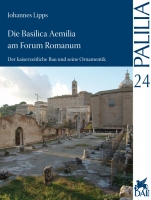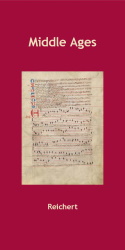Search
Die Basilica Aemilia am Forum Romanum
Der kaiserzeitliche Bau und seine Ornamentik
2011
22.0 x 29.0 cm, 252 p., 161 illustrations b/w, 21 tables, paperback / softback
ISBN: 9783895008702
22.0 x 29.0 cm, 252 p., 161 illustrations b/w, 21 tables, paperback / softback
29,90 €
ISBN: 9783895008702
Short Description
The Basilica Aemilia in the Forum Romanum is one of the most important buildings of ancient Rome due to its location, size and architecture. It is also especially well preserved in comparison with many other ancient buildings, and yet it has received very little attention in the scholarship. This study assembles and documents the surviving, Imperial-period remains of the building. This forms the basis for a detailed reconstruction of the building’s architecture, origins, and evolution. Particular emphasis is placed on the modes and meaning of the architectural decoration, above all with reference to the use of space and the broader urban context.Description
The Basilica Aemilia, the subject of this study, consists of a basilica fronted by a portico and shops. Its location, scale, and decorative elements make it one of the most important surviving structures of the ancient city of Rome. In comparison with most other ancient buildings, especially in the Forum Romanum, it is particularly well preserved, and therefore of special scholarly importance. Yet historically it is an understudied building, and the little work which has taken place has barely been published.The present study has identified and documented the majority of the surviving ornamental architectural fragments from the Imperial phase of the Basilica Aemilia. The aim has been to form a complete picture of the available evidence, and this has made it possible to understand the building in unprecedented detail. Due to the complexity of the evidence from the Forum Romanum, a special method was developed to create a critical catalogue of the core material. The architectural elements that form the basis for this study were divided into discrete series of fragments that certainly, probably, or only possibly belonged to the building, so as to avoid premature conclusions in the interpretation of the evidence.
To begin with, the objective was to analyse the ornamentation of individual architectural elements according to their technical characteristics, placement and workmanship thus to draw conclusions as to the reconstruction, chronology, and construction history of the building complex as a whole.
Using the reconstruction and findings relating both to the chronology and to the planning and construction process of the building complex, it was possible to pose questions relating to the use and meaning of the architectural decoration. Although it is impossible to appreciate the full spatial impact of the building as it existed in antiquity, nevertheless is it clear that the decoration was used to mark out different areas of representational space within the building. Several strategies were used, for example the conscious use of different materials or variation in the volume of ornamentation, which in places was specially worked to take account of the view from below. One purpose of all this was to invite the viewer to contemplate the function of the building in conjunction with its decorative splendour, and in this there can be no doubt that the highlight of the complex was the basilica’s central nave. In addition it would seem that efforts were made to integrate the basilica and portico with their respective and different urban settings.




 Preface
Preface

 Neuerscheinungen 2023/2024
Neuerscheinungen 2023/2024
 Gesamtverzeichnis 2023/2024
Gesamtverzeichnis 2023/2024
 Katalog Oriental Studies & Linguistics
Katalog Oriental Studies & Linguistics
 Mittelalter
Mittelalter
 Deutsche Inschriften
Deutsche Inschriften
 Musiktherapie
Musiktherapie
 Literaturen im Kontext
Literaturen im Kontext